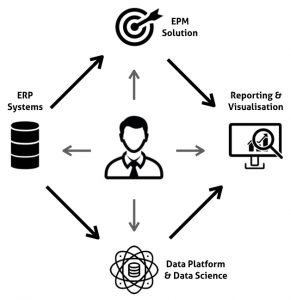Modern enterprise performance management: Making dreams a reality
Embracing powerful analytics is key, says Matt Chudleigh, principal EPM consultant at business intelligence and EPM consultancy Altius.
Embracing powerful analytics is key, says Matt Chudleigh, principal EPM consultant at business intelligence and EPM consultancy Altius.
Without wanting to sound too much like Martin Luther King, here at Altius, we have a dream. And that dream is to transform every organisation’s performance management and reporting capabilities.
We want to move organisations away from making critical business decisions based on siloed processes, manual entry and predefined timetables.
Our dream is to deliver a continuous stream of automated, machine driven forecast output based on advanced analytics, defined against strategic goals.
We’re talking instantaneous or event based output that is more than just insightful, delivered directly into the hands of decisions makers.
This is a dream that can easily become a reality – a reality for an organisation just like yours. But in order to explain how, we need to take a step back.
All organisations need the ability to chart the course of their business, having information readily available to allow informed, timely business decisions.
Enterprise Performance Management (EPM) systems have been serving this purpose for years and add value by providing the ability to understand where your organisation has been, predicting future performance.
But EPM systems have their limits. They still require a substantial amount of time spent on data entry and collating the budget and forecast data before it can be effectively analysed and presented to management.
Let’s put that challenge to the side for a moment whilst we look at the increasing use of data and analytics across organisations and enterprises of all sizes. More and more organisations are deploying modern systems for data analysis.
Why? Because large scale repositories can store vast quantities of data that can be made available for real time analysis, providing a granular level of detail and insight that was previously inaccessible.
Imagine the power, the insight and competitive advantage that can be achieved if you integrate your advanced analytics reporting into your EPM system.
That’s our vision – an integrated end-to-end analytical and management reporting process, starting from the source data systems, through to advanced analytics and data science, into EPM. Here’s how it could work.

A case study on EPM and analytics
We’ve recently helped a major player in the fitness industry use data science and advanced analytics to model and predict member attrition.
Our solution predicts which members are unlikely to renew their membership. This allows our client to target them with personalised marketing campaigns, resulting in reduced attrition rates.
But imagine the benefits to the business if that attrition rate output, which is a significant business driver, could be incorporated into the EPM solution and linked to other drivers in the EPM model, such as the number of new members joining.
It would easily drive far better insight into the overall financial picture of the business.
That’s because growing the membership base will have an impact on factors such as facility usage, demand for classes, cleaning, maintenance, consumable costs, the list goes on.
It simply isn’t enough to understand who is at risk of non-renewal, the business needs to understand what it needs to do if its marketing campaigns are successful!
Having a clear, timely and up-to-date understanding of the revenue profile can help management understand the true impact of actions and factors on profitability.
In the case of our fitness club client, analytical models can easily profile equipment usage and anticipated asset refurbishment and replacement. Linking the revenue analytics with the cost analytics within the EPM system gives a live view into organisational profitability.
Revenue profiling can be run as often as necessary, with management being alerted directly if there are any changes. In the event of the system predicting a downturn in revenue, additional capital and funds can be directed towards marketing and sales efforts as a direct result.
And all this can happen seamlessly with the analytical system and data science algorithms doing all the hard work. There’s no need for analysts to be involved in collating data, building and driving spreadsheets or simply transposing data.
Forecast data can be generated then overlaid with business goals and values that drive the business targets.
That doesn’t mean inundating management with reams of reports and interesting data. Having a single set of integrated systems, data and processes means that the correct data can arrive at the right time, enabling management to make informed decisions. Distinguishing interesting data from useful data is key.
Practically this means having the back-end technical systems integrated in a way that the output of advanced analytics and data science can be easily understood against strategic imperatives.
A data science algorithm that gives a future revenue forecast is interesting. A report showing the same revenue forecast, but how that affects the rest of the organisation’s finances is useful.
A system showing the same output, but allowing further modelling to be made to inform the best course of action is our ultimate vision.
Historically integrating these systems and processes meant a large scale development effort. Not today. With modern technical systems, the cost to implement and the total cost of ownership is substantially less than it was just a few years ago.
It is wholly within reach to have a fully linked set of analytics and performance management systems and processes in a short time frame.
Your biggest challenge isn’t going to be technical, it’s going to be cultural. Executives and staff must trust the analytics and systems output and be ready to increase the pace of review and decisions.
Lagging organisations have quarterly review cycles to adjust their course. Leading organisations have near instantaneous insight and can adjust as necessary.
To learn more about our EPM and analytics solutions, get in touch with Matt Chudleigh at Altius: [email protected] or visit www.altius.co.uk